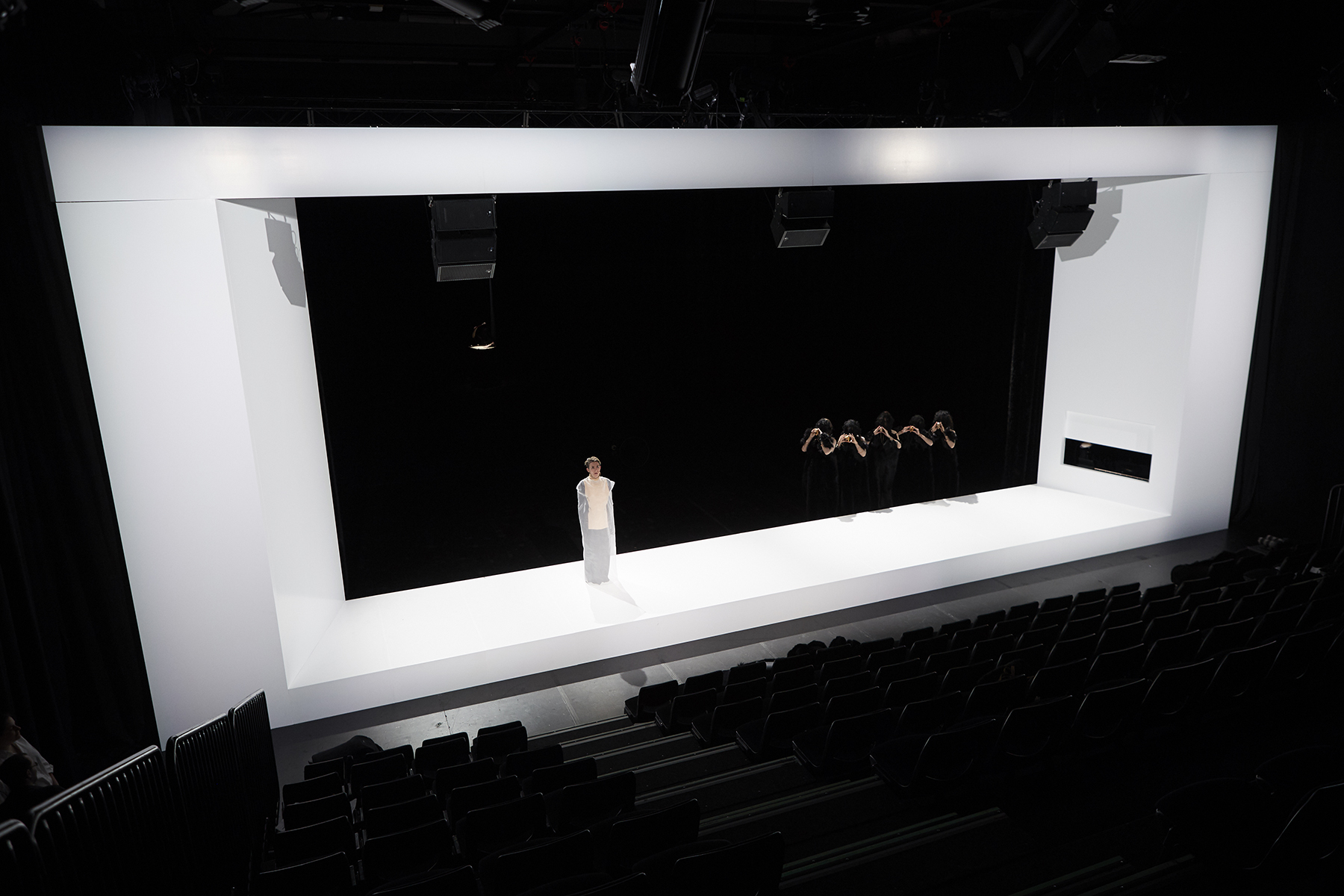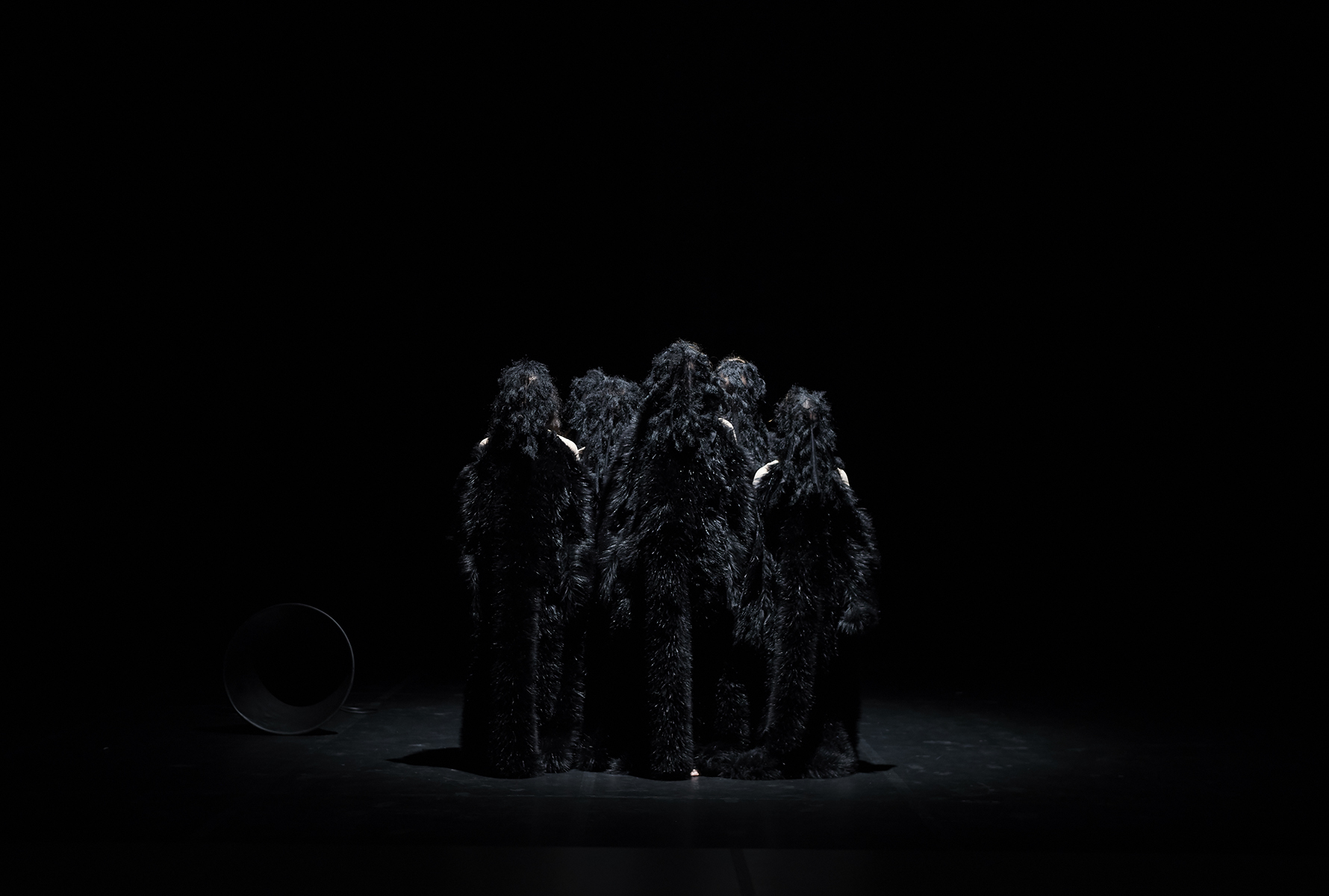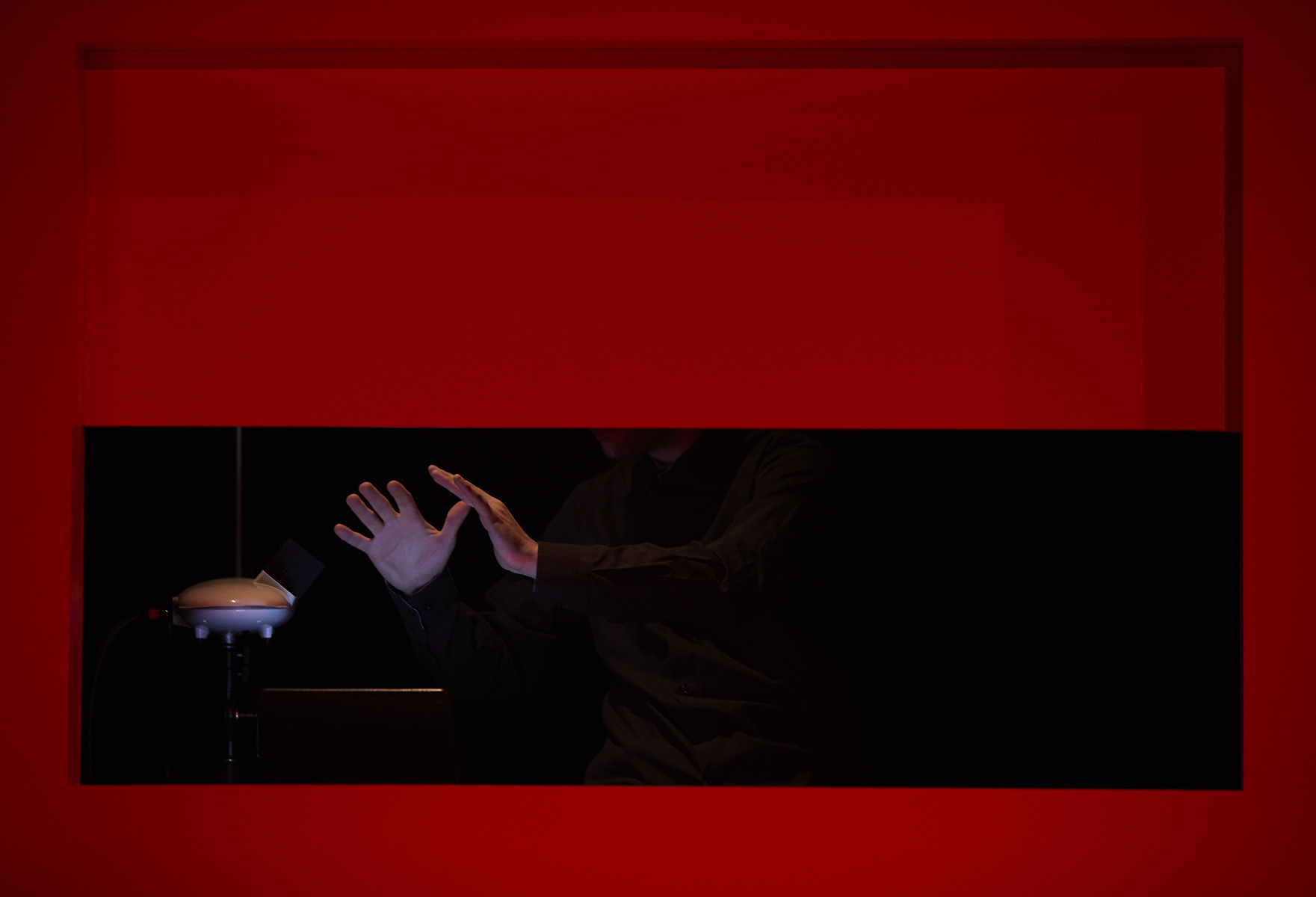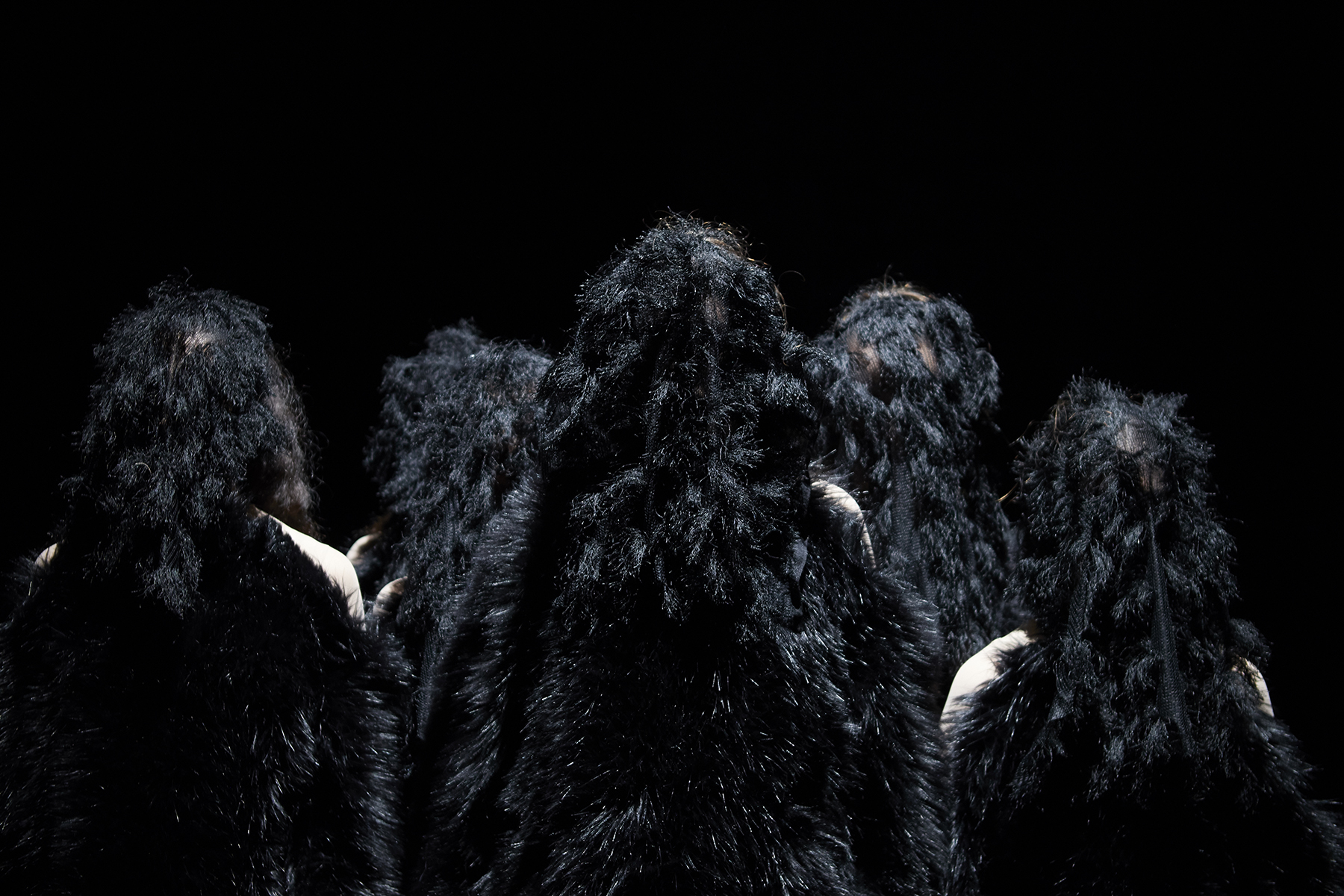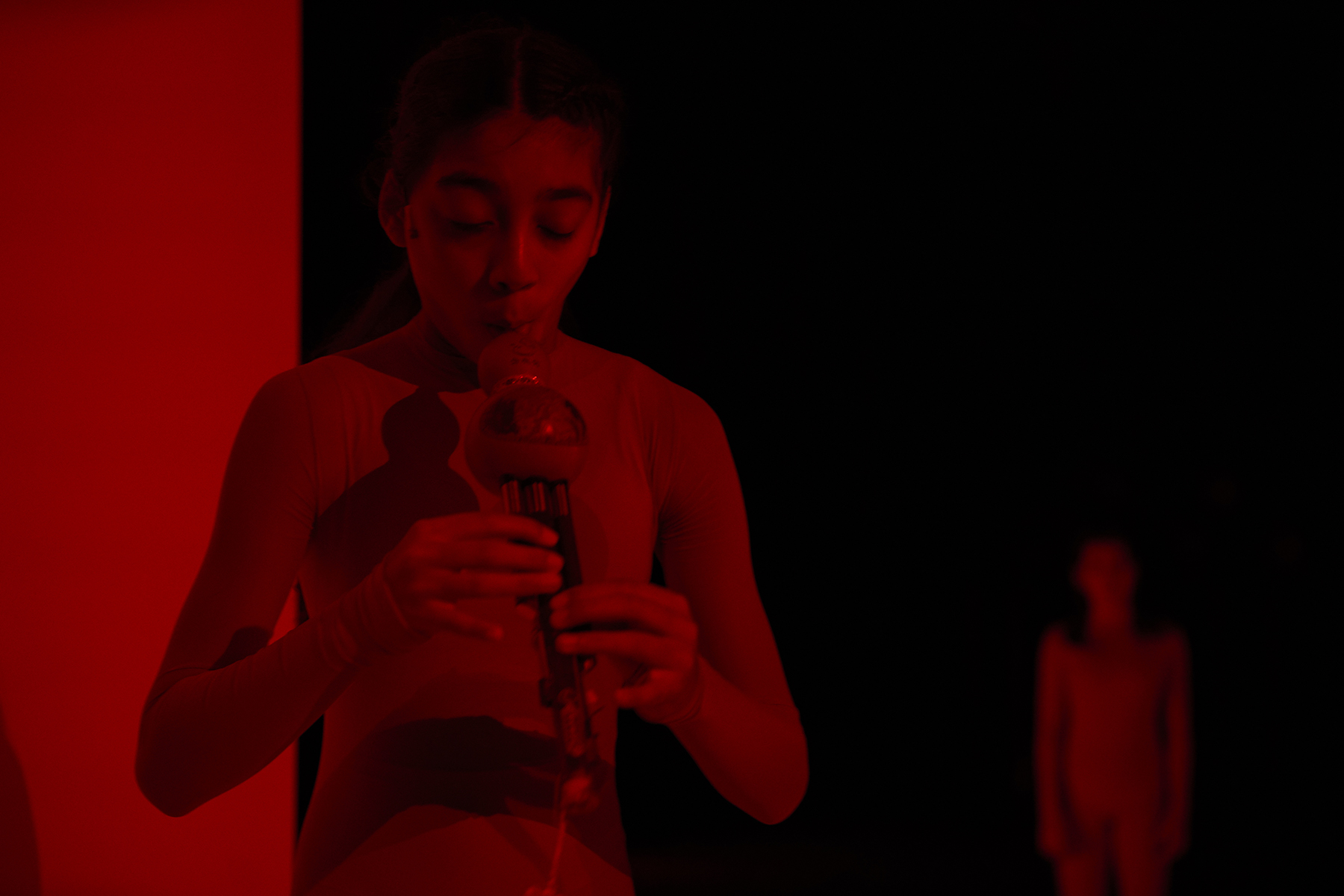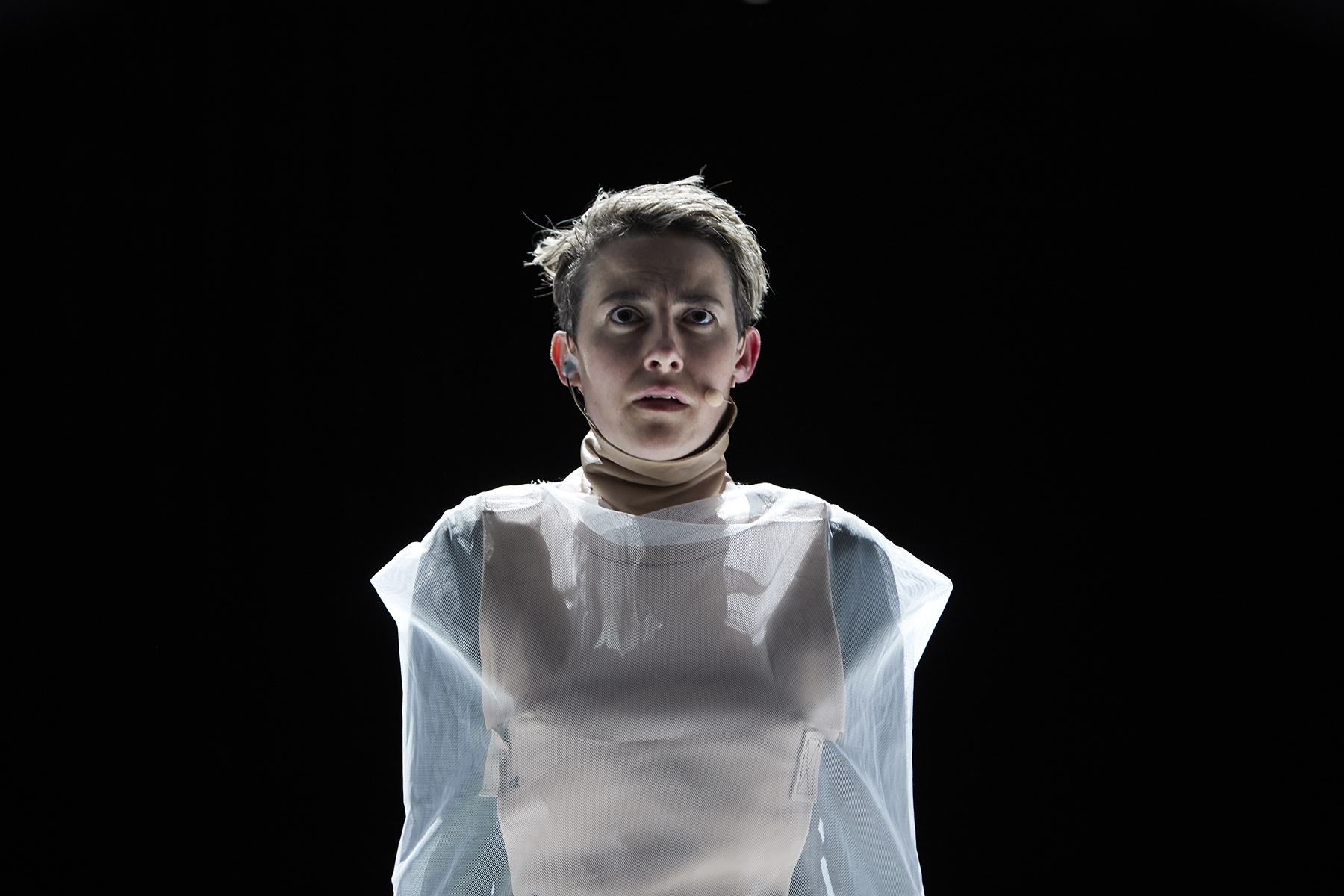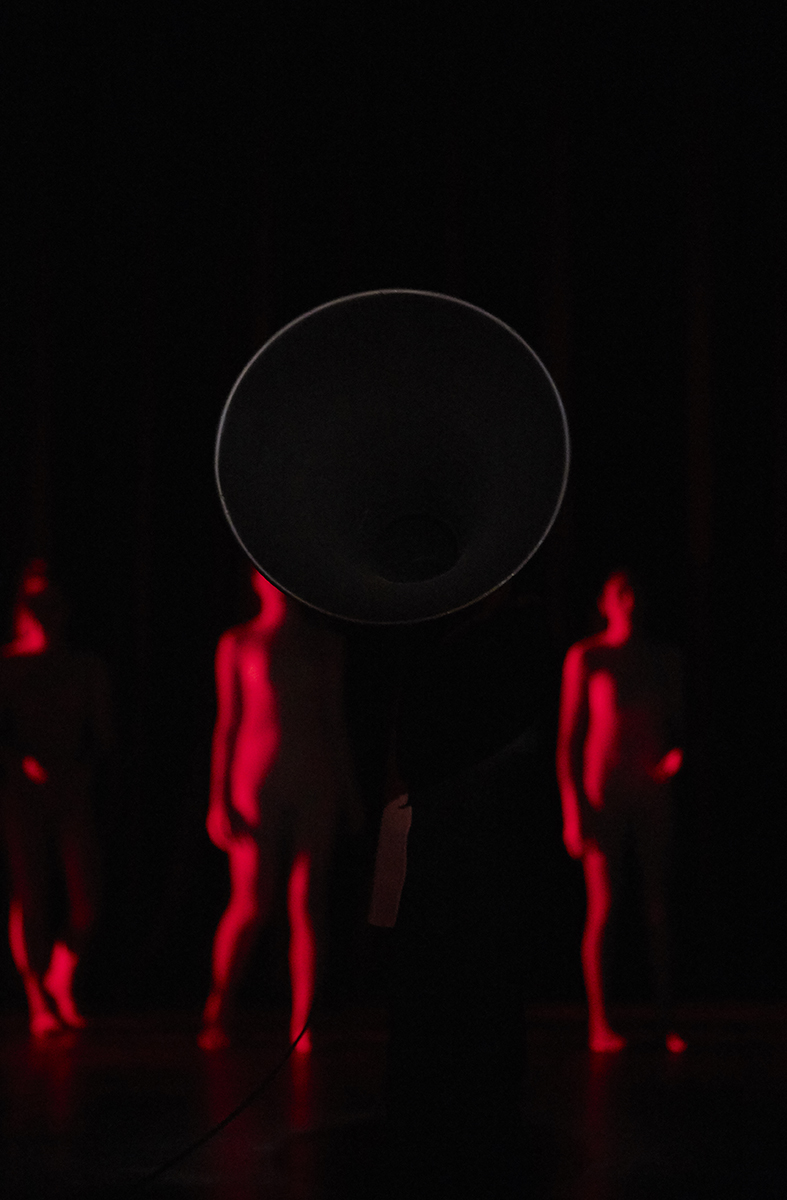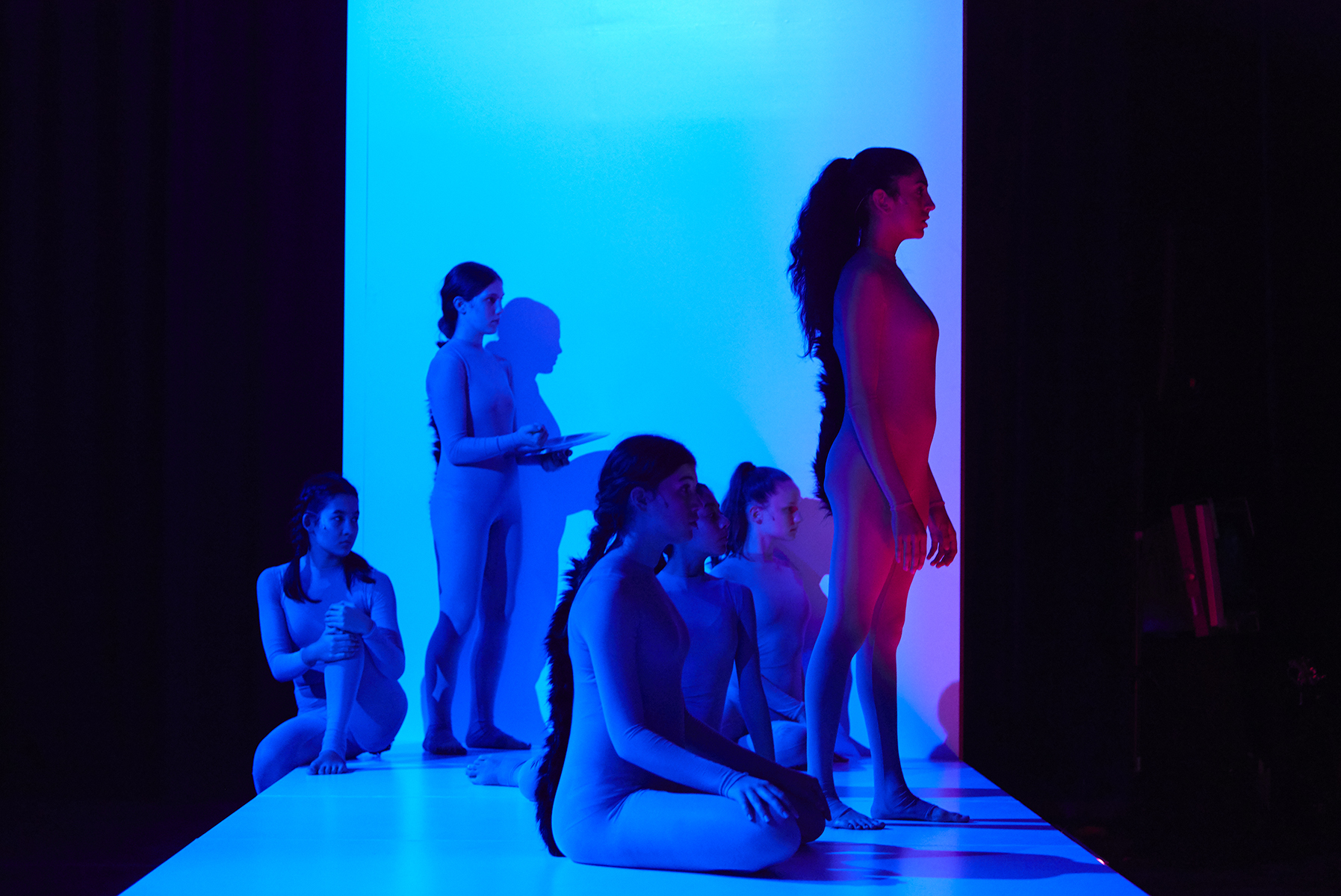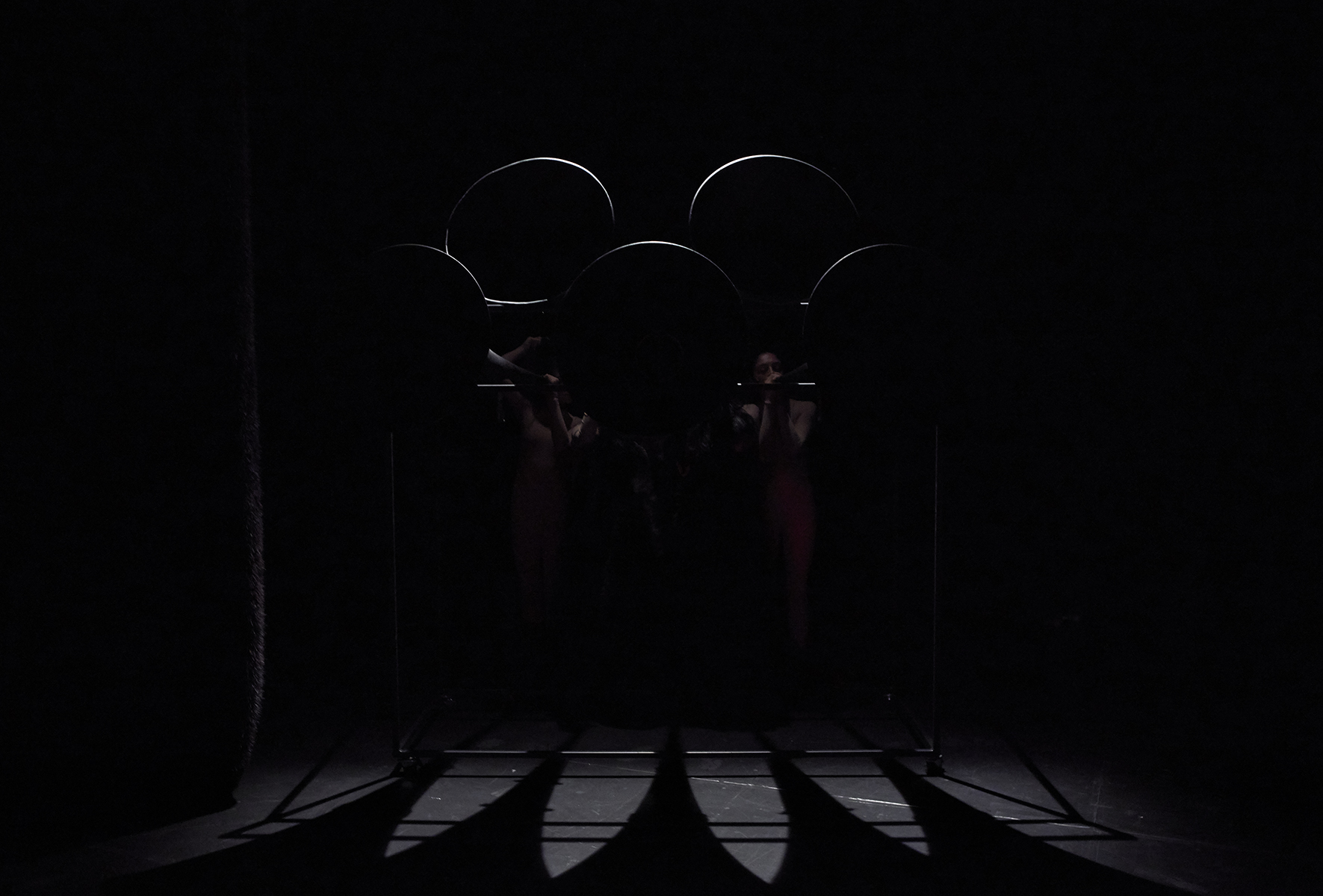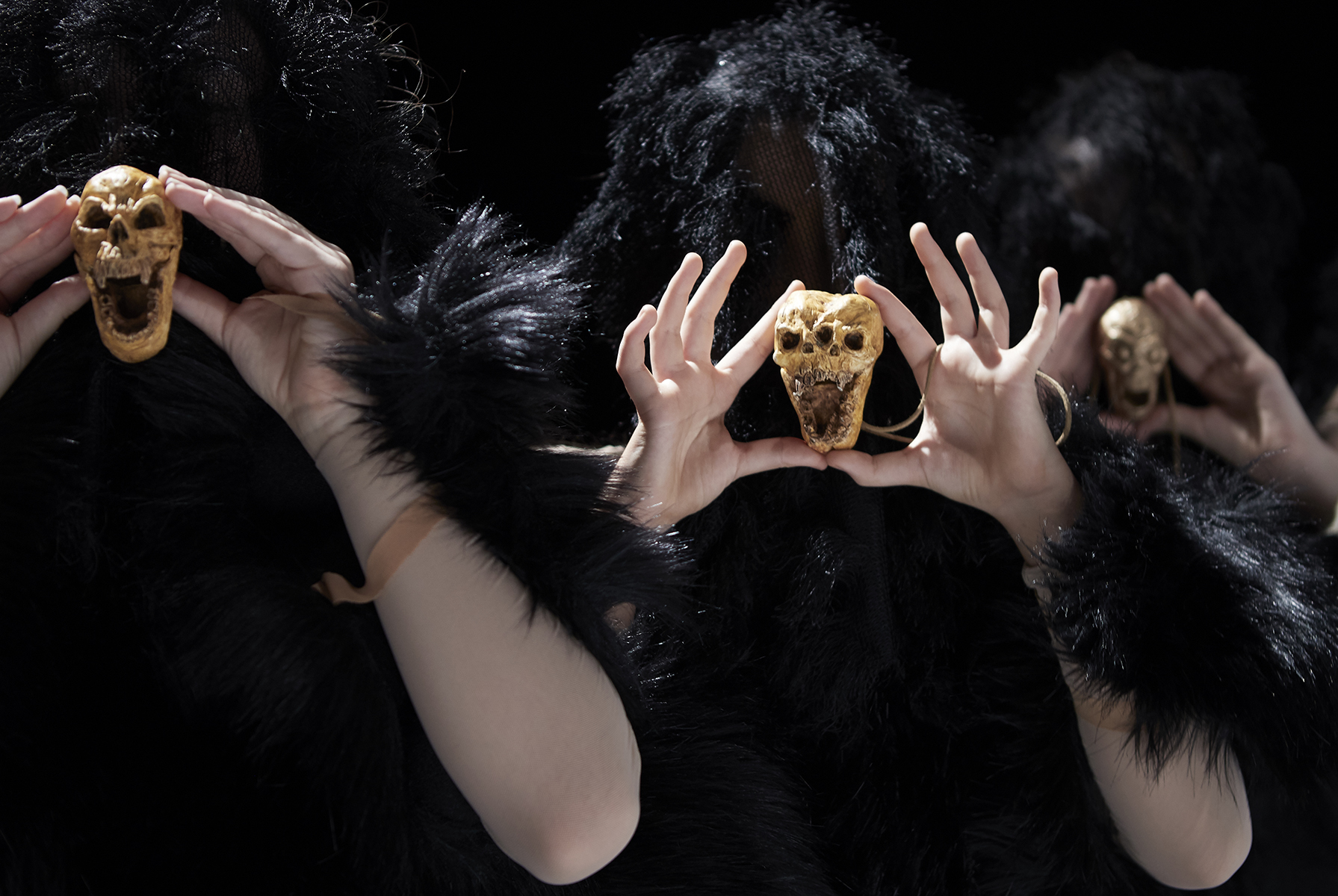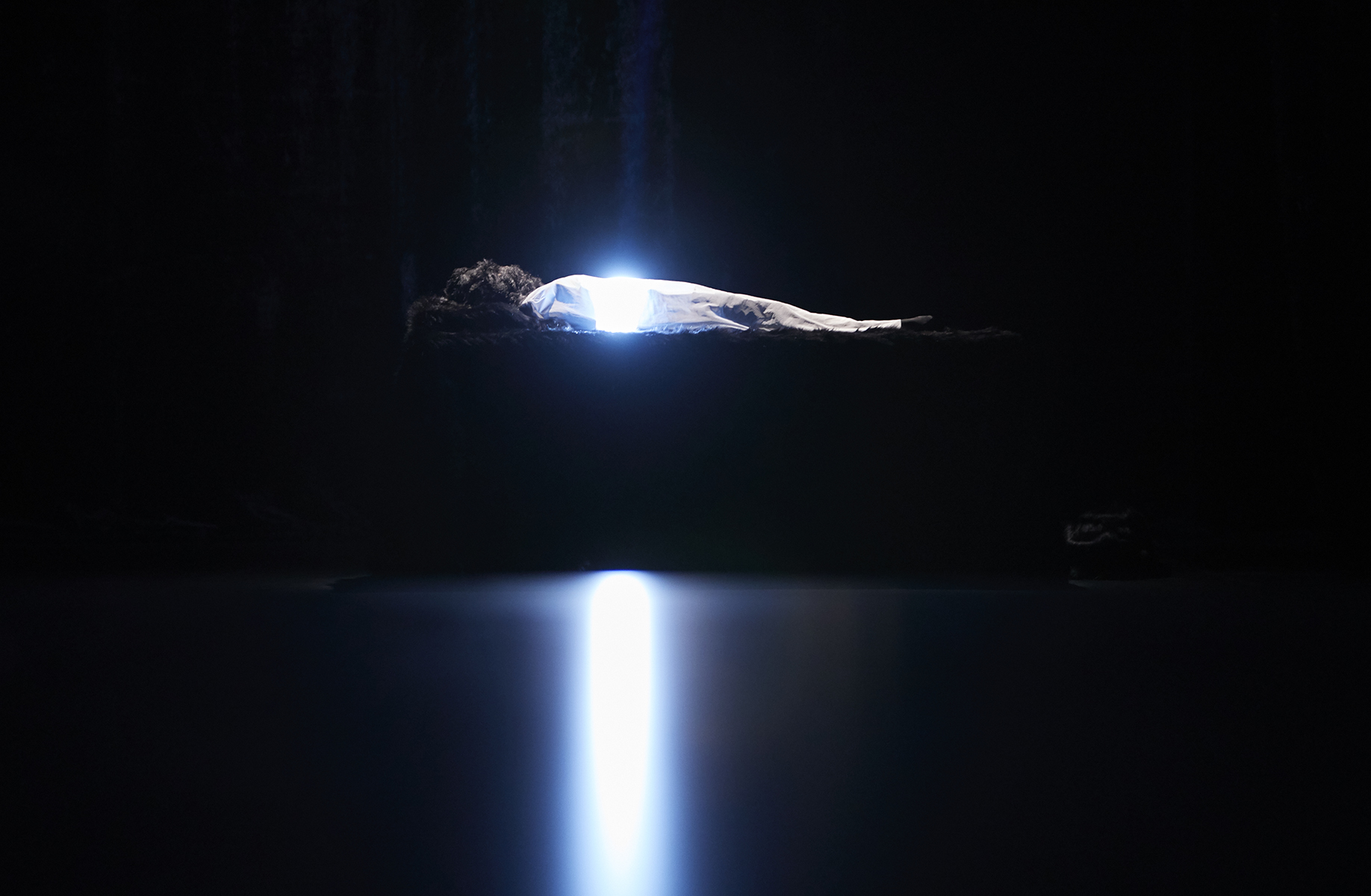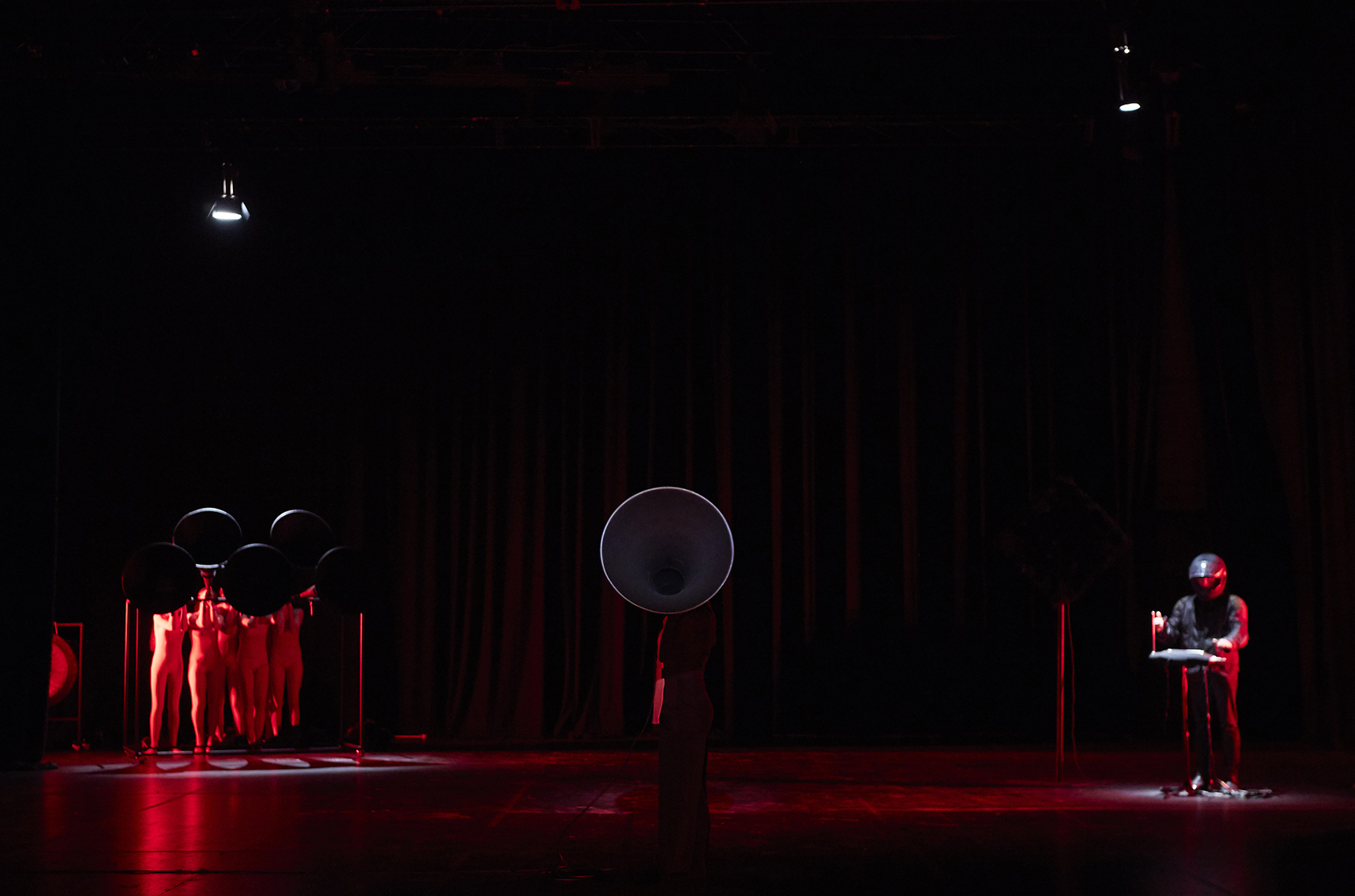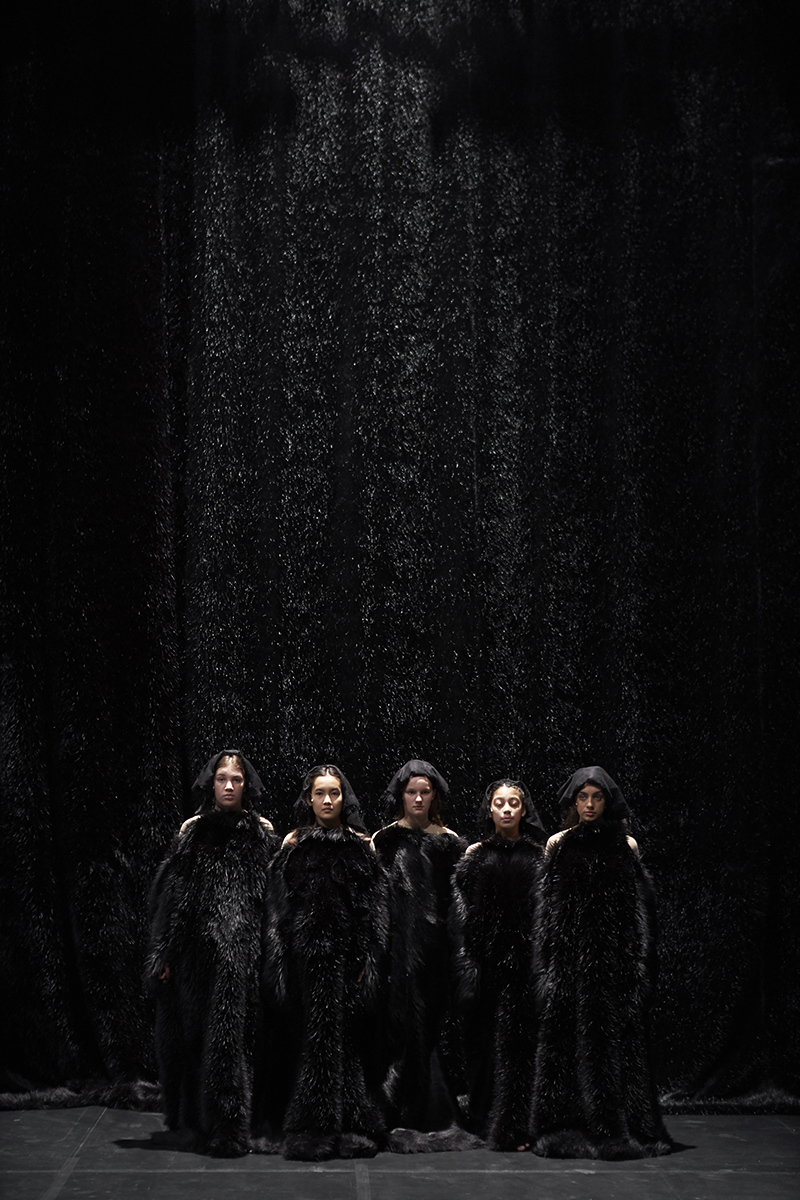Photo: Polly Borland, courtesy Murray White Room, Melbourne
The Howling Girls
opera by Adena Jacobs & Damien Ricketson
commissioned by Sydney Chamber Opera
produced by Performing Lines
featuring Jane Sheldon & artists from The House That Dan Built
Premiere season: 28 MAR - 7 APR 2018, Carriageworks, Sydney
Second season: 31 OCT 2019, Tokyo Metropolitan Theatre, Tokyo Festival
About the work
‘In the weeks following the terrorist attacks on the World Trade Centre...five gaunt teenage girls had arrived separately at a Manhattan hospital complaining of identical symptoms. They were wasting away because they couldn’t ‘swallow’... All five believed that some debris or body part from the destruction of the towers had lodged in their throats and produced the symptom. The ear, nose, and throat surgeon who examined the girls discovered that their throats were, indeed, constricted. But he could find no obstruction, no debris, and needless to say, no body parts.’ (Susan Faludi in The Terror Dream, recounting Judith Greenberg’s anthology Trauma At Home).
This haunting image became the seed for The Howling Girls. Five young women witness a collective trauma that is impossible to digest. Perhaps this anecdote is a metaphor for violation, the sense of being permeable, the terror that sets in when the familiar systems are collapsing - a larger trauma re-inscribed on the body and on the voice. Perhaps this is also a story which echoes a another collective trauma, that is the history of female ‘hysteria,’ a history of not being believed, of speaking a language deemed irrational and unintelligible.
Hysteria is controversial and mysterious territory. Robert Woolsey, a medical historian, considers hysteria to be a ‘protolanguage’ whose symptoms are ‘a code used by a patient to communicate a message which, for various reasons, cannot be verbalised.’ Within feminist discourse, it has been understood both as a means of controlling the female subject, and as a subversive force, a space of resistance which can disrupt and undermine the patriarchal order. Elaine Showalter writes; ‘Historically linked with femininity for hundreds of years, hysteria’s involuntary, uncontrollable, somatic symptoms were coming to be understood in the emerging critical feminist discourse not as a medical condition but a cultural one, an embodied index of forms of oppression.’
The Howling Girls explores the medium and metaphor of the voice. Featuring a solitary soprano and a throbbing chorus of young voices, together with an immersive orchestration of theremin, keyboards and electroacoustic music, the score itself is a kind of proto-language, an attempt to communicate in a mode beyond the rational: a sensory spectacle to bypass the brain and work directly on the body.
The work unfolds in the trajectory of a single utterance. Beginning with the lungs: the engine room of the voice where the first transformation from mind to matter occurs with the squeeze of this bodily bladder of air - channelled into the throat: the fleshy organ pipe-cum-string instrument translating energy into vibration - to the crucible of the mouth and its attempt to forge this plasmic substance into an articulate mass - to its final expulsion from the lips in a rupture from the body to the outside world.
For us, this experiential work functions as a ritual or purgation, in which the desire of reconstituting the voice is performed. The Howling Girls inhabits a space which is seemingly alien, at once primordial and futuristic, a fantasy of new possibilities for language and gender, a landscape of sensations, a monument and a void which gives way to something new.
ADENA JACOBS, DIRECTOR & DAMIEN RICKETSON, COMPOSER
Images
Photos by Zan Wimberley
AWARDS
Co-winner of the 2018 Music Theatre Now Competition
The Howling Girls was one of 10 winning productions from 436 nominations from 55 countries in the 2018 Music Theatre Now competition.
Winner of the ‘Vocal/Choral Work of the Year’, in the 2019 Art Music Awards.
Finalist in the 2018 FBi SMAC Awards in the category ‘Best on Stage’.
The Sydney Music and Culture Awards are an annual celebration run by popular music radio station FBi.
Winner of Best Sound Design in the Tokyo Festival World Competition 2019
Archival video
Recorded live at Carriageworks. Videography by Hospital Hill, audio recording by ABC Classic FM
Critical reviews
“As she [Jacobs] and Ricketson present a series of simple but richly evocative images and sounds, they’re inviting the audience to look inward. There are moments that are aurally and visually confronting and discomfiting, and others that are sublimely beautiful and meditative in their impact.
The work isn’t so much about how we understand these tableaus as a collective, but the kind of thoughts and music they throw forth for each individual audience member. Jacobs and Ricketson have carefully orchestrated just about everything, except for your emotional response.
There are times in the work where the sense of trauma and suffocation is nearly overwhelming, but by the end we find ourselves very much looking toward the light. Somehow, after 70 minutes of experimentation and invention, the women on stage have found a way forward as individuals and as a group, crafting a new expression. That’s also true of Sydney Chamber Opera, which has pioneered a more uncompromising form of opera over the last few years. This is the pinnacle of their daring provocations and an essential work for anybody wanting to experience the cutting edge of the operatic art form.”
“The Howling Girls is a memorable opera without words, sparely physically animated, pictorially and sonically immersive, a remarkable celebration of the voice and, with a utopian aura, a continuation of the feminist project to de-pathologise and give voice to the extremes of women’s experiences.”
“A remarkable tour-de-force – a 60-minute exploration of boundaries of vocal possibilities …
A significant element in sustaining that atmosphere was the discreet finesse of Ricketson’s electronic sounds, directed by Symonds and balanced with refinement by sound designer Bob Scott. Eugyeene Teh’s black and white costumes were fantastic visions welling from the darkness with the logic of a dream.
one realised that this was not an artistic construct that could be pushed along in any way, but, rather, one that had to unfold according to its own mysterious inner evolution, like a collective psychosis that passes into dim light.”
“We hear her. We hear them all. Now, the voices are different. Now, they move beyond constraints and into creation. Now the sounds belong to the women who howl, and they are in control of it. A drum beats. The women chant, move forward, elevate Sheldon’s cry with percussion and movement and their own haunting voices. Maybe the women have forged a new way of speaking. Maybe they will never be silent again.”
“This acutely uncomfortable production establishes Sydney Chamber Opera as our local pupping ground for visionary operatic performance that seeks to enthrall by rearing thought.”
“Sheldon develops a timbre like that of the eastern European “white voice” heard in Slavic women’s choirs. Beneath it, a bass rumble like some far distant avalanche is turned on and off. Above it, a note is picked up and set to ringing by a chorus of six young performers
Visually, there are moments of considerable power (Sheldon’s Butoh-like procession across the forestage, for example) but the emotional force of the piece is overwhelmingly sonic.
Sheldon’s command of pure and profane vocal sounds is remarkable. Her stamina likewise. In cahoots with musical director Jack Symonds’ theremin, electronic treatments developed by Ricketson and sound designer Bob Scott, and a mini-orchestra of shrieking Inca death whistles, it is overwhelming. The Howling Girls coils around the listener like some impossibly ancient Siren song.”
“The opening sequence of Sydney Chamber Opera’s The Howling Girls plunges the audience into a liminal world that evolves so slowly the slightest sonic or visual shift reverberates with unexpected power.
But the dreamlike world of Ricketson and Jacobs’ opera, which has no libretto, is more a deeply felt response to ideas of trauma, powerlessness, grief and communication, than straight story-telling, though there is an arc that builds slowly throughout the piece through both the evolution of vocal sound and Jacobs’ visceral staging.
This opera is no mean vocal feat and Sheldon’s “choking cadenza”, a brutal interruption to the broader arc, is a strange and affecting moment.
Ultimately it is the immersive mystery of the long opening sequence that lingers in the mind, like some vivid but half-remembered nightmare.”
“Visually and aurally the work is disturbing, none more so than the moment when the six veiled girls appear to taunt Sheldon by sounding the death masks.
The 70-minute piece will certainly not be to everyone’s taste in the expectation of attending an opera. However, much credit must accrue to one of Australia’s most innovative opera companies, the Sydney Chamber Opera, and to all involved. It is a bold experiment in how the human voice, singly and collectively, can be stretched almost to breaking point, while providing a vivid investigation of responses to trauma.”
“Considering that opera’s focus is on the conveyance of thought and emotion via vocal musicality, this unusually libretto-less work runs against the grain yet manages to leave a powerful impression that highlights the vocal struggle to get there - in this case to communicate in the context of trauma, of collective grief and, through a sense of powerlessness, hysteria.
As a concept, The Howling Girls is experientially rewarding, highly visceral and sonically ingenious, captivating and intriguing in the way it has interpreted unimaginable trauma… The creative aspect of opera-making is always welcome - in this case you could say ‘opera installation’ - and, at the very least, The Howling Girls adds further depth and inspiration to the evolution of the art form.”
Writings
Emilie Collyer. “Other Utterances: Transformational possibilities of poetry in performance” Axon: Creative Explorations, Vol 11, No 1, July 2021
Damien Ricketson. “Sites of Violence: Music, Trauma and the Non-Verbal Voice” Sydney Environment Institute, University of Sydney, 08/10/2020
Selected media profiles
“Female bodies are “always on the front line, the first place in which politics plays out and where society tries to reinstate control,” ...
The Howling Girls may be a wordless opera. But it is by no means silent. It is telling that it has emerged as women are finally beginning to talk, in whatever means they have. Women “are getting tired of being the recipients of the country’s illnesses”, says Faludi. They are saying, “I kept quiet. No longer.””
““[I was] trying to create a sonic world and music that would bypass the brain and work directly on the nerves or the body,” he [Ricketson] says.
”I want the audience to feel like they are in Jane’s throat, fused with her body in some way.”
”It’s proposing a sort of utopian ideal of a remaking of the voice, or a purification of the voice,” she [Jacobs] says.
It is a purification Jacobs feels we need desperately in these times.
”It’s no accident that after the [US President Donald] Trump election there was a women’s march,” she says.
”We’ve got women rising up to say that the people who are in power are denigrating our bodies and controlling our bodies, and vocally saying this needs to stop.
”I don’t know if it’s possible that the history of trauma or oppressive forces can be undone or can be taken away … I think it’s very hard to release ourselves from those things,” she says.
She concludes on a hopeful note: “I think this work actually proposes something new, a clean slate … And I think it ultimately heads into a place of beauty.””
““Women’s bodies and voices are always the first site in which [conservative] politics play out, where control is instituted. But we have witnessed such strong voices of resistance too, from women, non-binary and queer voices.”
”I actually don’t experience the piece as wordless as such, because it’s so articulate, and there’s very little silence,” Jacobs says. “It feels as if it’s summoning a new form of language or speech, one which sits outside of the discourse of language.””
““Adena Jacobs and Damien Ricketson turn us inside out with THE HOWLING GIRLS. Their attempt to express trauma specifically located in female bodies succeeds not only onstage, but also piercing our audience bodies. The soundscape and staging of this piece is ambitious and non-apologetic, giving a much needed time, space and voice to pain, and us, as audience members, permission to experience it.” ”
Behind-the-scenes videos
Three part series commissioned by Carriageworks
Credits
Composer – Damien Ricketson
Director – Adena Jacobs
Musical Director/Theremin/Keyboard – Jack Symonds
Set and Costume Design – Eugyeen Teh
Lighting Design – Jenny Hector
Sound Design – Bob Scott
Soprano – Jane Sheldon
Ensemble (from The House that Dan Built) –
Grace Campbell, Kittu Hoyne, Kiri Jenssen, Emily Pincock, Jayden Selvakumaraswarmy, Sylvie Woodhouse
Production Manager – Damion Holling
Stage Manager – Cecilia Nelson, Millie Simes
Assistant Director – Danielle Maas
Assistant Conductor – Huw Belling
Assistant Designer – Tyler Hawkins
Costume Maker – Amanda Agnes
Director, The House That Dan Built – Danielle O'Keefe
Audience response
“Howling Girls is a brilliant disturbing utterly amazing show. Jane Sheldon is just stupendous. Damien Ricketson’s music is wild and imaginative. Expertly directed by Adena Jacobs. The most out there production yet by the wonderful Sydney Chamber Opera.”
“I left the show covered in a light layer of sweat and a pain in my side. I still have the pain a week later, powerful stuff.”
“I’m still feeling and thinking about it, one of the strangest and intriguing sonic and visceral experiences!”
“Howling Girls was insane in the best possible way. Thanks for creating/dreaming this awesome thing that’s no doubt left an impact on many (including me!)”
“I felt like I went through a neon-Druidic rite ... The images created visually and of course musically... arresting, amazing. Blown away by the courage involved on all fronts.”
“It was an extraordinary experience, and we left feeling quite overwhelmed and affected (in a good way).”
“I found the performance compelling, challenging and beautiful, and found myself thinking on it for most of the weekend”
“That show was game changing. Huge!”
“One of the most challenging and interesting musical works I’ve heard in a long time. An opera without words...a tragedy without plot...psychologically searing and strangely edifying ... made me feel terrified, disconcerted and glad to be alive.”
“A total triumph! Every person around me was going ballistic at the end. Thank you”
““Howling Girls”, Sydney Chamber Opera, Carriageworks is SCOs strongest work yet. Incredibly impressive, confident and disciplined score from Damien Ricketson and laser focus direction from Adena Jacobs.”
“awesome to see the way Sydney audiences embraced this crazy ass concept, music and staging”
“Awesome amazing & a game changer!
”
Images by Samuel Hodge


